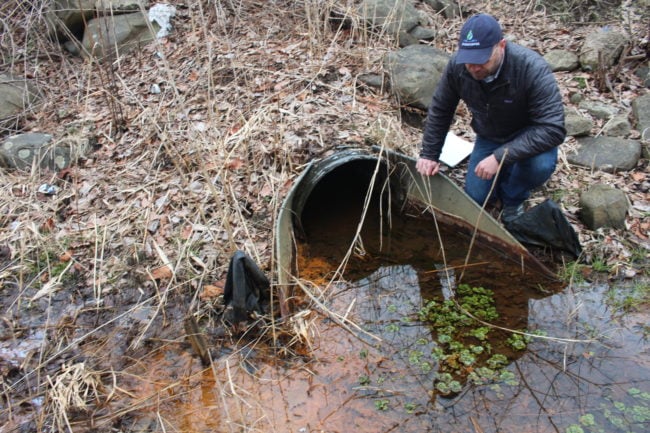As a watchdog for Newburgh’s drinking water, Riverkeeper goes beyond PFOS

Dan Shapley, Water Quality Program Director, observes an orange-colored discharge from a stormwater outfall near the Stewart International Airport in Town of New Windsor. (Photo by Leah Rae / Riverkeeper)
View more images on our Flickr site
Riverkeeper’s work in Newburgh since the city’s primary drinking water reservoir, Washington Lake, was found to be contaminated with toxic PFOS has drawn much attention. But our work doesn’t stop there. Our work in the area in recent years started with collaborative monitoring project with the Quassaick Creek Watershed Alliance, and we continue to act as a watchdog for water quality in the watershed serving the city’s reservoirs.
We successfully made the argument for a new state commitment to drinking source water protection in the reservoir’s watershed, and the project is well underway. Our aim is to make sure Newburgh’s source water protection plan is a model for the state. We successfully advocated not only for Newburgh, but for a new commitment to protecting drinking water statewide, and Gov. Andrew Cuomo signed the Clean Water Infrastructure Act last week, including $110 million for new drinking source water protection initiatives.
We care about these streams not only because people rely on them for drinking water, but because it’s our mission to protect the tributaries of the Hudson River. Ultimately the health of the river depends on the health of the creeks and streams that feed it.
Two recent examples of our on-the-ground work in Newburgh are below. While neither represent major sources of pollution, each is indicative of the challenge of protecting water quality broadly, and specifically in watersheds that serve as drinking water. Newburgh’s particular challenge is an extreme case in point, as there is heavy transportation, commercial and residential development in the watershed for its reservoirs, which lie entirely outside city limits in adjacent municipalities. Every square foot of pavement, every sewer line and every storm drain is an incremental risk.
Vigilance against pollution is required. New York City benefits from dedicated funding for wastershed protection, and a police force devoted to patrolling the lands around its upstate reservoirs, even hundreds of miles from the Five Boroughs, but there is far less capacity for this essential function elsewhere in the state. The new state funding is an essential and welcome boost to that capacity.
Reporting suspicious discharges

Dan Shapley, Water Quality Program Director, observes an orange-colored discharge from a stormwater outfall near the Stewart International Airport in Town of New Windsor. (Photo by Leah Rae / Riverkeeper)
On February 22, as Riverkeeper joined city and state staff, and the Quassaick Creek Watershed Alliance, for a tour of the reservoir watershed as part of research for completing our Drinking Source Water Protection Scorecard, we came upon two pipes with concerning discharges. One, a permitted stormwater outfall from the Stewart International Airport, had algal growth indicating that the discharge had both high nutrient content and high temperature. The other, an unpermitted outfall, had an orange discharge indicative of iron in the soils. While the appearance of the discharges is likely worse than any effect downstream, we reported them because we believe we need heightened vigilance to water quality, particularly in watersheds that provide drinking water.
Fortunately, the Department of Environmental Conservation shares that concern, as evidenced by a pilot project, focused on Newburgh for now and ultimately statewide, to provide easy public access to DEC information about facilities, permits and compliance in the Newburgh area. The DEC is also putting more resources into investigating complaints and concerns that occur in watersheds that provide drinking water.
The DEC responded to our report, and traced the source of the unpermitted stormwater outfall we identified to Stewart International Airport. The outfall, previously unmapped, will be included in a permit update for the Port Authority of New York and New Jersey. That will provide for better oversight of discharges from this location going forward.
Reporting a sewage spill properly
The Sewage Pollution Right to Know Law, passed thanks to Riverkeeper’s advocacy in 2012, requires municipalities to report sewage overflows and leaks that reach water. The law requires municipalities to notify adjacent municipalities in particular, and to identify any public areas affected by the discharge.
On April 22, 2017 (Earth Day), the Town of New Windsor reported a blocked sewer pipe that resulted in the overflow of about five gallons per minute of raw sewage reaching Washington Lake, the city’s primary reservoir. The Town of New Windsor took action to stop the overflow, but didn’t follow the reporting requirements. While the City of Newburgh’s reservoir is currently out of service until a new filtration system is put in place that can remove PFOS, the town’s alert didn’t recognize the reservoir as a “public area,” and failed to notify the City of Newburgh directly as an adjacent municipality.
We reported both issues, and DEC is following up to ensure that mandated work to reduce infiltration and inflow of stormwater into the town’s sewers, which can cause sewage overflows, includes attention to the sewer lines in this area.
